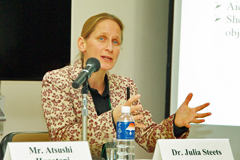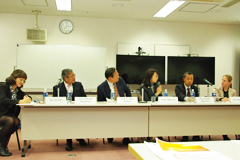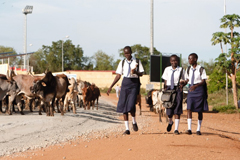Linking Humanitarian Aid and Development Aid: A Lively Discussion With Julia Steets and Other Experts
2017.01.16
A link between humanitarian aid and development aid is considered to be crucial to overcome a humanitarian crisis. This message was reaffirmed at the first World Humanitarian Summit, held in May 2016. As a part of the JICA Research Institute (JICA-RI) research project "Comparative Study of Humanitarian Crisis Management from the Perspective of Bilateral Cooperation Agencies," JICA-RI held the open seminar "How can we help overcoming humanitarian crisis? - New perspectives linking humanitarian and development action" on December 12, 2016 at the JICA Ichigaya Building.
In the seminar, Julia Steets, Director and Board Member of Germany’s Global Public Policy Institute (GPPi), and Atsushi Hanatani, Director of Office for Peacebuilding and Reconstruction, JICA, a former JICA-RI Executive Senior Research Fellow who also served as Chief Representative of the JICA South Sudan Office, gave presentations. After the presentations, with moderation by JICA-RI Senior Research Fellow Ako Muto, JICA-RI Visiting Fellow Yukie Osa (Professor, Rikkyo University), Professor Toshiya Hoshino (Osaka University) and Professor Hiroshi Higashiura (Japanese Red Cross College of Nursing) discussed about the presentations and related issues.
In her lecture, Steets said that the gap between humanitarian aid and development aid creates various problems. She pointed out that opportunities are missed, aid is less effective and efficient, and short-term interventions can undermine longer-term objectives. For example, despite a temporary classroom being built as part of a humanitarian aid program, if a permanent school building is built elsewhere as part of a longer-term intervention, it can create duplicated expenditures. Another example is Haiti, which had an advanced healthcare system. After a disaster, healthcare services were provided for free by international aid donors. This caused local clinics and hospitals to shut down, and ultimately, the healthcare situation was worse after the aid was provided.

ulia Steets, Director and Board Member of Germany’s Global Public Policy Institute

Panelists discuss a link between humanitarian aid and development aid
Steets also pointed out that "organized hypocrisy" was a factor preventing cooperation between humanitarian aid and development aid for many years, despite the widespread understanding of its importance. This means that, despite agreeing with such concepts as "seamless aid" and "continuum," donors and organizations each give it their own interpretation and act in accordance with that interpretation. To solve this type of problem, it is necessary to eliminate conceptual confusion and make the concept more transparent and easy to understand.
Steets also explained the difference between humanitarian and development aid. Humanitarian aid requires quick response for life-saving objectives, but development aid takes time to accomplish mid-and long-term objectives. Humanitarian aid acts according to the humanitarian principles of impartiality, neutrality and independence, while development aid is provided through the recipient government. Their ways of operating are very different. In her concluding remarks, she said although it is important to fill in the gaps between humanitarian aid and development aid, this does not mean that humanitarian organizations and developmental organizations should be completely integrated. She said that it is needed to establish cooperative relationships and systems between the two aid communities to respond to the changing needs of people.
Hanatani pointed out that countries that accept refugees place low priority on aid for refugees. He added that development aid donors are also faced with the dilemma of the difficulty of putting effort into aid for refugees, since aid is provided in accordance with that country’s development plan. Hanatani compared Tanzania and Zambia, which have accepted many refugees, and explained that in Zambia, where Japan also assisted in the development of the local community, the government and donors collaborated for smoother provision of aid to refugees.
In the panel discussion, Muto explained that the gap between humanitarian aid and developmental aid is a frustrating issue for many people, and that sharing success stories would be helpful in promoting the continuity from humanitarian aid to development aid. Professor Osa focused on the approaches to refugee aid taken by Arab countries and BRICs, which are new donors. Professor Hoshino suggested the Sustainable Development Goals as a guiding principle for actors working for both humanitarian aid and development aid since many countries have agreed on SDGs as a common goal. Professor Higashiura explained that the Red Cross activities cover everything up to the recovery phase, including capacity-building. Steets introduced some efforts made by donors, such as pooling funds for local organizations, and delivering financial aid directly to victims rather than through an intermediary organization.

JICA assisted in the reconstruction of South Sudan
A lively discussion was conducted, including questions from the audience, such as what role the private sector can play in the area of humanitarian aid.
Finally, JICA-RI Deputy Director Nobuko Kayashima closed the seminar, saying, "I hope we can integrate the insight from today's seminar into our current project and use the ideas discussed today in order to improve the projects of JICA-RI."
The project team is currently working on the final outcome, a book including six case studies which are the Syrian crisis, Timor-Leste, South Sudan, Indian Ocean Earthquake and Tsunami, Typhoon Yolanda and Hurricane Mitch.

事業事前評価表(地球規模課題対応国際科学技術協力(SATREPS)).国際協力機構 地球環境部 . 防災第一チーム. 1.案件名.国 名: フィリピン共和国.

事業事前評価表(地球規模課題対応国際科学技術協力(SATREPS)).国際協力機構 地球環境部 . 防災第一チーム. 1.案件名.国 名: フィリピン共和国.

事業事前評価表(地球規模課題対応国際科学技術協力(SATREPS)).国際協力機構 地球環境部 . 防災第一チーム. 1.案件名.国 名: フィリピン共和国.

事業事前評価表(地球規模課題対応国際科学技術協力(SATREPS)).国際協力機構 地球環境部 . 防災第一チーム. 1.案件名.国 名: フィリピン共和国.

事業事前評価表(地球規模課題対応国際科学技術協力(SATREPS)).国際協力機構 地球環境部 . 防災第一チーム. 1.案件名.国 名: フィリピン共和国.
scroll